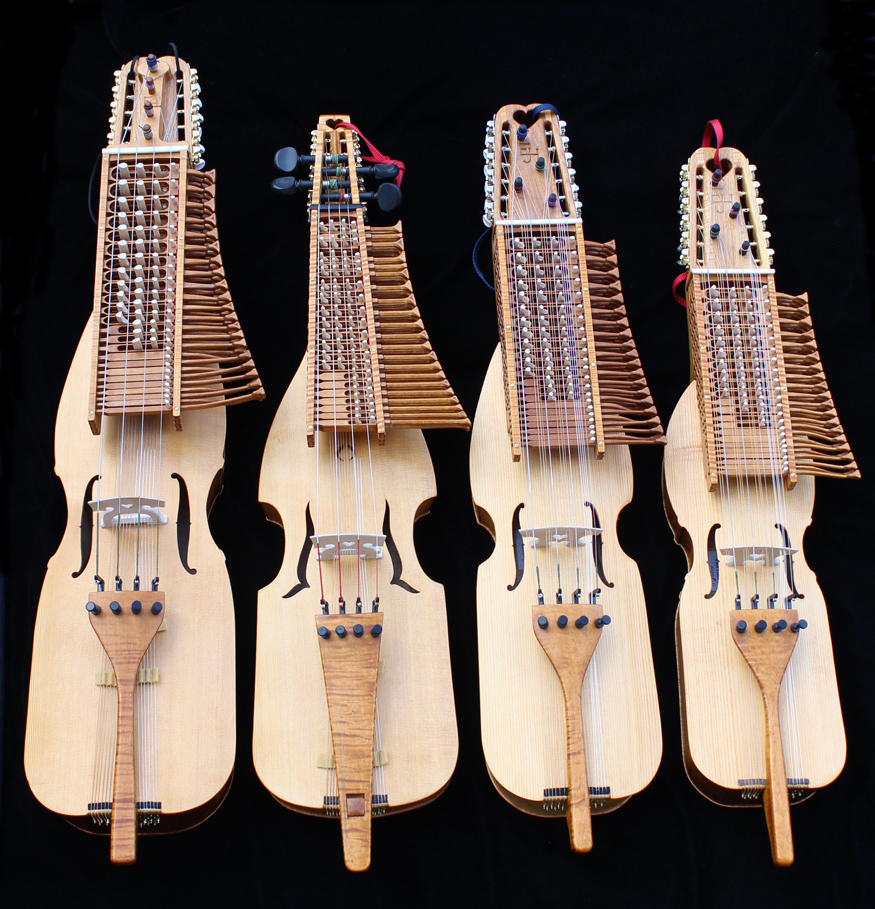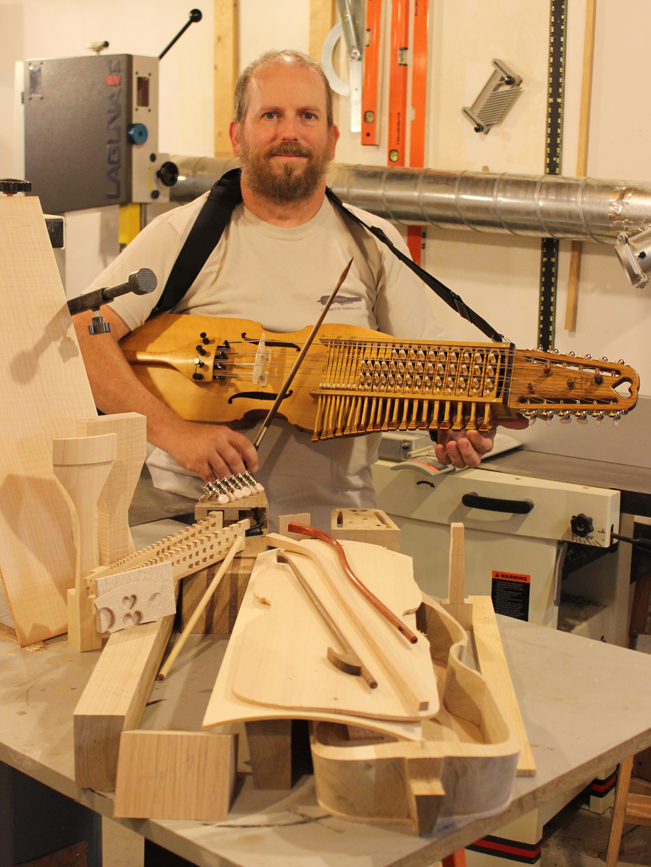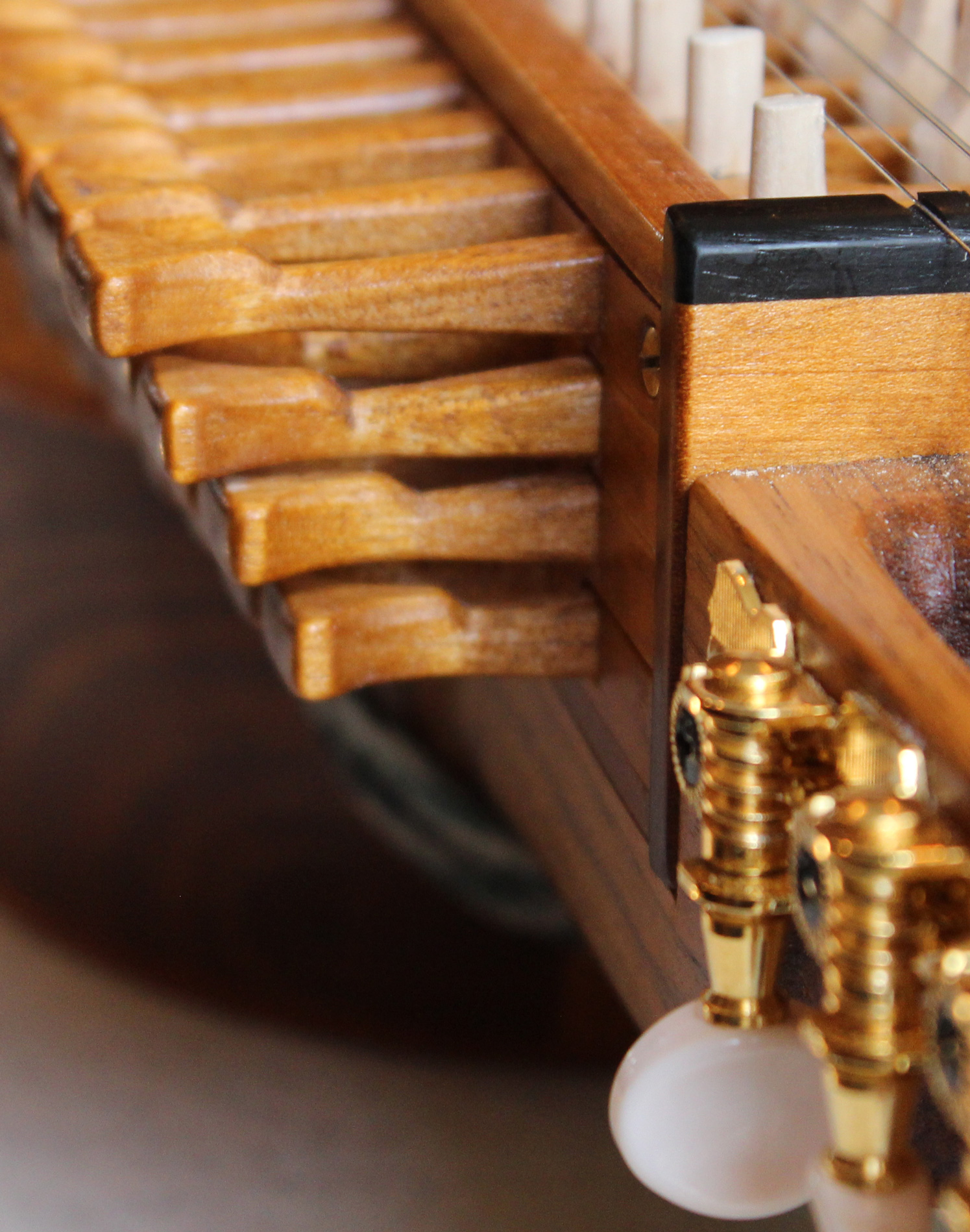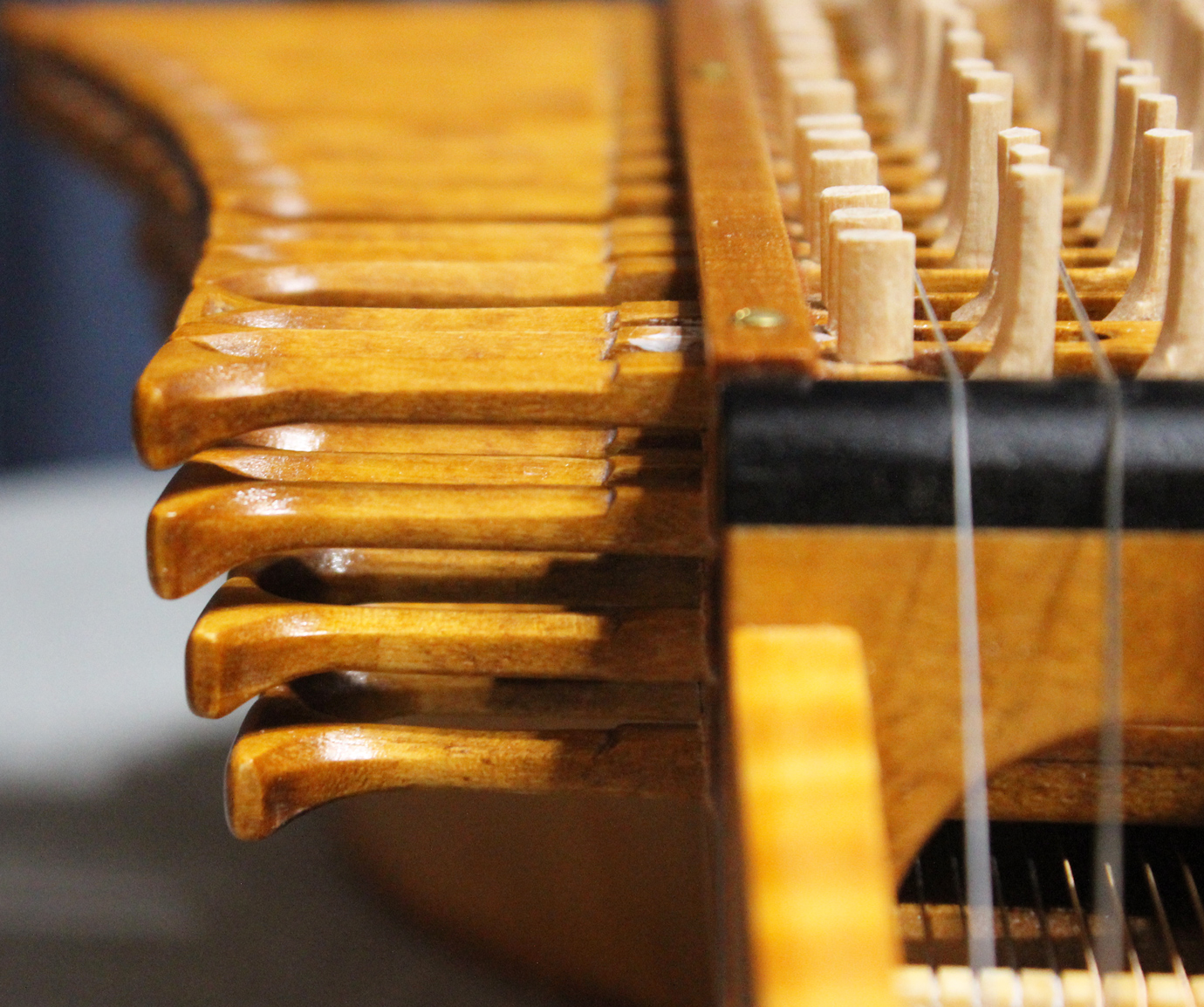
- About Nyckelharpas
- What is a Nyckelharpa?
- Nyckelharpa History
- Modern Nyckelharpas
- Beginner Nyckelharpas
- Tuning a Nyckelharpa
- Desired Characteristics of a Nyckelharpa
- Nyckelharpa strapping
- New Nyckelharpas
- Nyckelharpa Bows
- Nyckelharpa Cases
- Maintenance
- Services / Repairs
- Nyckelharpa Strings
- Nyckelharpa Books & CDs
- Accessories
- Building Nyckelharpas
- Ordering Information
New Nyckelharpas
 Earl now builds several different models of nyckelharpas.
Earl now builds several different models of nyckelharpas.
The nyckelharpas he builds have a louder volume than most 4-rowed instruments being made. They also have a good even tone across the playing strings with all but just a few of the keys having good sound. Note: most nyckelharpas have at least several kays that really do not sound good. The sympathetic resonation is also very good. These are very good sounding instruments with key boxes intended for advanced players.
Earl builds nyckelharpas that can be used for whatever type of music someone wants to play on it.
Mostly he builds and sells new nyckelharpas. He also does repairs on nyckelharpas from other builders.
Prices: In general, nyckelharpa prices range from about $2500 to $10,000. Please note that there are no factories, they are all hand made.
The cheapest you can typically get a Swedish 3-rowed nyckelharpa from Sweden is about $2500.
There are very few used nyckelharpas available. Any you find for less than $2000 may not be playable.
Out of respect for the Craftsmen/Craftswomen who build nyckelharpas please do not ask about “cheaper” instruments. It takes a significant amount of time, materials, tools as well as skills to build a nyckelharpa. It is very disrespectful to ask us to give away our craftsmanship.
About the first 30 nyckelharpas Earl built were 3-rowed chromatic nyckelharpas based on the Eric Sahlström model in both the full and 3/4 sizes. The body has solid wood sides that are tapered to make the back a little smaller for ease of holding. The nut-to-bridge (mensur) length is 400mm (340mm for the 3/4 size). The standard model has a 7-10-22 key set. Earl is not building any more 3-rowed nyckelharpas. He will typically only have one if he gets it on a trade-up.
He is now building 4-rowed soprano (violin range), alto (viola range), tenor (an octave below the violin range) and cello nyckelharpas.
After several iterations, Earl was able to get a good sounding 4-rowed soprano with a slightly smaller body. He has built intermediate (with shaped sides) and advanced (with bent sides) instruments, both with very good sound. Due to key buzzing issues on a couple of the thin-bent side instruments, he has decided to make only the shaped solid wood side instruments at this time. He did develop several key sets but has decided to only make the advanced 10-12-14-22 key box with the more vertical key tip setback that works well for people who have advanced violin/fiddle experience. The advanced key set allows for playing double stops up into 5th violin position with ease. The key tip rows with the more vertical position allows for hitting two adjacent row keys easily with a fingertip. The additional keys allow for cross string playing up the key box. If intermediate/advanced players have extra keys available, they use them.
After several years of working on it, Earl is now making Alto nyckelharpas with a 12-12-15-22 key set.

For the tenor, he is using the Johan Hedin plans developed in 2004. This harpa has tapered bent-wood sides similar to what is used on violins or guitars. The sympathetic resonation strings are below the keys. The neck and keybox are tapered to account for the amount that the strings vibrate. This instrument is tuned in fifths, one octave below a violin. The plans as designed have 70 keys including a number of ¼-tone notes. Responses he has received indicate that this key set is designed for advanced players who are doing early/baroque music that includes the ¼-tone notes. Pictures are in the photo gallery.
About ¼-tone keys and notes: They are a little hard to explain to someone not familiar with them. The use of ¼-tone notes is a carryover form the long transition from the anhemitonic pentatonic into the current chromatic or diatonic scales system. There are some cultures that still use ¼-tone notes in their music, including some Swedish Kulning (shepherds songs). The early Enkelharpa and Esseharpa did have ¼-tone notes. Boris Koller has written an article about it in German, available at http://www.cadence.articles.nyckelharpa.eu/anhemitonische-heptatonik_boris-koller.pdf.
Earl also makes a cello range nyckelharpa with a 12-15-15-24 key set. Based on input from players, this instrument can be played loud with no string/tangent buzzing and has 2 full octaves on the top A string. Like the tenor, the cello nyckelharpa has the sympathetic strings below the key box. This is done to reduce neck width and weight. It does result in less resonation as compared to the soprano and alto models. Pictures are in the photo gallery.


The picture here on the left shows a comparison between the standard setback between the rows of keys (on the left) and the more vertical advanced key set. This more vertical style was developed on the Johan Hedin tenor.
We have one 3-rowed Swedish range left-handed nyckelharpa available. The 4-rowed models need to be ordered.
Prices range from $6500 to $8000 depending on the specific model and extras. These prices are for new nyckelharpas as of the end of 2022 (instrument only):
Soprano model with solid wood-cut sides & 10-12-14-22 key set: $6500
Alto model with solid wood-cut sides & 12-12-15-22 key set: $6500
Tenor model with bent sides & 12-12-19-19 (+ 2 ¼-tone notes on each row) key set: $6500.
Cello model with solid wood-cut sides & 12-15-15-24 key box: $7000
Upgrade options (pictures are in the photo gallery) available are:
- the keys and key box can be ebonized and stained black: add $200
- a red tint with a semigloss finish: add $300
- to add a glossy, French polish: add $300
- a more highly figured maple back. Earl typically uses 4A grade maple on his soprano instruments, but has 5A and quilted maple on hand for more dramatic figuring: add $100
- the standard top is a clear sitka spruce with some grain width variations (grade 1A). To upgrade to a 3A/4A with narrow uniform grain: add $100
About the color and tone of Earl’s nyckelharpas: Earl is using a light stain to bring out and enhance the natural beauty of the wood. This allows you to see the wood grain. The key box and tail piece are darker tones to show a contrast from across the room. Earl likes this a lot and, except for the black key option, is not interested in dark color on an instrument.
A guitar strap and a cello peg wrench are included with each instrument.
A kit for a soprano nyckelharpa, which includes a standard case (backpack straps, external pockets), beginner bow, Jule Bauer book and rosin add $600. Changes to the bow will adjust the price based on the bow prices. The tenor and cello cases cost a bit more. Recently, the case prices have been going up due to increases in material costs.
Sales tax and shipping are extra.
Due to the use of a CNC router system, it is not easy for Earl to customize a key set for just one person. He also uses the CNC for the key guide strips. The use of the CNC gives good repeatable precision. We have heard from advanced players that Earl's keyboxes are some of the best being currently made.
We have a 60-day return policy. If within 60 days, you decide to return the instrument, we will take it back. The customer will be responsible for the shipping costs both ways, plus $100/month (or portion of a month). If the instrument had any upgrades, the cost of the upgrade is not refundable.
Humidity and harpa key box: One significant issue about nyckelharpas is that the key box and keys are made of wood and will be affected by changes in humidity. The gaps in the key box are made with minimal clearances. If the gaps get too big, it results in a buzzing sound that many players find irritating. What most builders do is make the keys work for the ambient air temperature and humidity that exists where they live. If the new home for the nyckelharpa has significantly higher humidity, it causes the keys and key guides to swell and some keys will stick. The fix is to partially dis-assemble the key box and a small portion of material is removed from either the key or the key guide to let the key move again. This needs to be done in the high humidity setting where the nyckelharpa now resides either by the owner or a friend/instrument technician who can do these adjustments.
We live in northern Wisconsin. Sweden is actually a cooler/drier climate than Wisconsin in the summer. Earl recently had to re-adjust the keys on a new Swedish-made nyckelharpa that now resides in Minnesota. This is a common new nyckelharpa owner issue in the first year.
Much of the southeastern portion of the United States gets quite a bit warmer and more humid than we will ever see in northern Wisconsin. Earl is doing a key and key box treatment to try to partially stabilize the key box against changes in humidity. He thinks he is reducing the humidity affects by maybe 50 to 60%, but not eliminating the sticking problem totally. If you are having a sticky key problem and want to talk with someone about it, please feel free to give Earl a call. It does not have to be on a nyckelharpa that he built. We have added videos on our nyckelharpa maintenance channel on YouTube showing how to do this with Earl’s 4-rowed key boxes. This includes detailed instructions for fixing sticky keys.
Earl provides free adjustments and minor repairs on any nyckelharpa built by him, limited to normal wear and tear on the instrument. This warrantee does not include negligent damage due to dropping, being sat on, aggressive playing techniques (wears out tangents prematurely and can break keys), etc. Additional warranties may be included on specific instruments on a case by case basis.
(Note: Any text that is a different color and underlined is a link to another web page. Clicking on it will take you there.)
(Page last updated 1/25/2023)